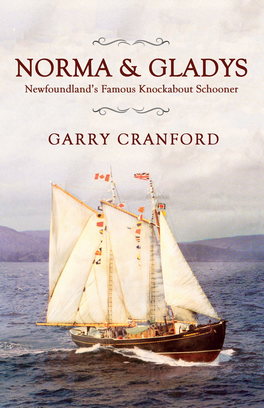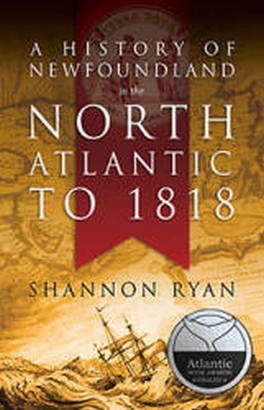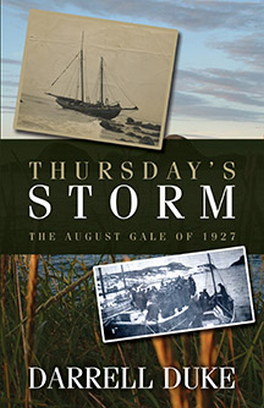Launched in 1945, the schooner Norma & Gladys illustrates the best qualities of Newfoundland and Labrador’s industries of shipbuilding, the Labrador fishery, the Grand Banks fishery, and coasting freight to remote seaside towns. Her story also illustrates the worst examples of the province’s favourite bloodsport: partisan politics. In 1973, she was purchased by the provincial government and refitted as a floating maritime museum; her political legacy soon included innumerable blunders and cover-ups, mutiny, a stowaway, and perhaps the ghost of a sealing captain. In 1975, Canada’s External Affairs appointed Norma & Gladys as a roving ambassador to promote fisheries management within a 200-mile coastal limit. But she was unseaworthy; Clarenville Shipyard had installed the wrong masts, and her itinerary to sail around the world was scrapped. After a frontal assault by the media and political partisans, she nevertheless promoted the province to 78,900 visitors in nineteen European ports. She returned with her reputation restored, her signal flags flapping like a hundred gypsy scarves on the breeze. “On Friday, January 16, 1976, at nine o’clock in the evening, Liliana Wagner stowed away under the canvas of one of the port dories.” “Eight pumps could not keep her afloat. Norma & Gladys had sprung a perfect leak.” Of her coasting years: “You’d know when Norma & Gladys was in port. Every man would be dodging up the road with a bologna on his back.” Alan Hillier On the world tour: “I was in Captain Jack’s bad books. . . . I had to put in the pigs. It was the worst day of my life.” Charlie Parsons “In the face of critics and storms, Norma & Gladys does represent something romantic, something glamorous, and it’s been a job well done.” Premier Frank Moores, August, 1976
In construction type, Norma & Gladys was referred to as a knockabout schooner, a design originally drafted by Boston ship’s architect Captain Thomas McManus. This class of vessel had no bowsprit, or long projection from the bow to extend the volume of sail carried. In a knockabout, the forward sail—the jib—was fastened directly to the stem, instead of extending forward to be tied to the tip of a bowsprit or jib-boom. This made it easier for the deckhands to access and reduce canvas, especially in rough weather.
Most of the work had been done and everyone in the villages near Monroe looked forward to the launch, which took place on May 26, 1945. Captain Tucker had decided to name his new schooner after his two daughters, Norma and Gladys, who were five and eighteen years old, respectively.
The last big job required of the dockworkers prior to launch was the construction of a cradle to support the hull as it slid off the dock. This cradle was attached to flanged skids resting on rails that were greased to make them slippery. Part of this cribwork included upright posts, the upper ends placed under the hull, with the lower ends resting on the base of the cradle. At each post, men used mallets to drive in wedges, causing the vessel to slightly lift off the keel blocks, at the same time transferring the weight onto the cradle through the upright posts.
Mrs. Gladys Stone, Henry W. Stone’s daughter-in-law, broke a bottle at the stem as a dockworker released the rope holding the vessel in place. The vessel and cradle then slid into Smith Sound, where the cribbing separated from the hull, allowing it to float free and clear.
Local Newfoundland Anglican Minister Rev. G. R. Frampton saw many of the launches in Monroe and remembers the spring of 1945: “I was fifteen years old at the time and was attending the one-room school at Gin Cove, about a mile from Captain Henry Stone’s shipyard at Monroe. During the war, a number of ships were built at Monroe by Captain Stone, and I was launched in several of them, including Norma & Gladys, but details of the launch of any particular ship escape me, as it was quite a common occurrence in those days. As schoolboys (and girls) we would all flock to Monroe when a launch was about to take place, and it was a great thrill to be on board a ship as it slid down the way. The launch always took place, of course, during a high tide, for obvious reasons.”
Captain Tucker got a start when the cradle slid into the water. As it submerged into Smith Sound, the cribwork, with Norma & Gladys riding high, stopped and shuddered as if it had collided with a rock! For a split second he thought the schooner had been damaged. Actually, it was only the supporting framework that had grounded. The cradle disintegrated, and the vessel floated free and clear.
The shipyard personnel then prepared Sid & Sam and launched her within an hour. Four days after the event, the Evening Telegram reported:
Two new sailing vessels were added to the marine life of Newfoundland when the schooners Sid & Sam and Norma and Gladys slid gracefully down the launchway into their element at Captain Henry Stone’s shipyard, Monroe, states a message received Monday by Gerald S. Doyle. Both vessels are of the auxiliary type, the Norma and Gladys which was built for Allan Frecker (sic) of St. Jones Within being powered with a seventy-five horsepower Lathrop gasoline engine and the Sid & Sam, built for Roland Butt of Flat Islands having installed an eight-five horsepower, full diesel engine. Constructed by the veteran shipbuilder Captain Henry Stone, both vessels are splendid examples of their type and were completed in the comparatively short time of four months.
Captain Allan Tucker took delivery of Norma & Gladys right away. “She was launched with the spars in her. The canvas was all battened on her and the anchor was ready. When she went off the cradle she was anchored, and the next day I hove up the Tickle, anchored in St. Jones Within, and came ashore. She didn’t even have a deck engine on her the year I had her. We had to heave the anchor and the canvas by hand, using the old-fashioned windlass. We had no electric lights, ordinary kerosene lamps in the cabin and fo’c’sle. If you wanted to clear away fish up on the deck at night, we had two large Coleman lanterns.”
Delivered to St. Jones Within, Norma & Gladys was ready to earn her place among the thousands of schooners that had gone down north to the Labrador floater fishery.
The story is well written and appeals to all readers- historians or not. A small schooner that is a vivid part of this province’s background, Norma and Gladys: Newfoundland’s Famous Knockabout Schooner is well worth the read.-- Tint of Ink --
Informative and often highly entertaining.-- Chronicle Herald --
Well organized and laid out, [Norma & Gladys: The Famous Newfoundland Knockabout Schooner] provides a look at the life of the schooner Norma & Gladys from her building to her eventual and unexpected loss in Placentia Bay.-- Northern Mariner --























